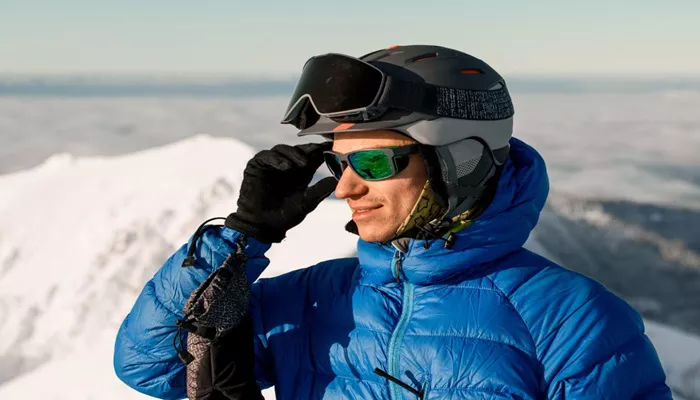Spring skiing offers a unique experience with warmer temperatures, softer snow, and longer daylight hours. However, dressing appropriately for spring skiing is crucial to stay comfortable and enjoy the slopes without overheating or getting too wet. Unlike winter skiing, where layers are primarily focused on warmth, spring skiing attire requires a balance between breathability, moisture-wicking, and protection against unpredictable conditions.
This guide will cover everything you need to know about what to wear for spring skiing, from base layers to outerwear, and the best accessories to enhance your skiing experience.
1. Understanding Spring Skiing Weather Conditions
Spring skiing conditions vary significantly throughout the day.
Mornings can be crisp and icy, while afternoons often bring slushy snow and warmer temperatures. Key factors to consider include:
Temperature fluctuations: Early morning and late afternoon can be cool, while midday can feel quite warm.
Sun exposure: The sun is stronger in spring, making UV protection a must.
Snow conditions: Softer, wetter snow requires gear that keeps you dry and prevents overheating.
Understanding these factors helps in selecting the right clothing for a comfortable ski day.
2. Base Layers: Moisture-Wicking and Breathable Fabrics
The base layer is the foundation of your spring skiing outfit. It should:
Wick moisture away from your skin.
Keep you dry without overheating.
Provide a slight level of insulation for chilly mornings.
Best Base Layer Fabrics
Merino wool: Naturally breathable, moisture-wicking, and odor-resistant.
Synthetic blends (polyester, nylon, or spandex): These materials dry quickly and wick sweat effectively.
Avoid cotton: Cotton absorbs moisture and stays wet, making you feel damp and cold.
Recommended Base Layer Options
Lightweight or mid-weight long-sleeve top: Opt for moisture-wicking performance shirts rather than heavy thermal layers.
Thin leggings or lightweight base pants: If temperatures are on the warmer side, you can wear thin, breathable leggings or even skip the base layer altogether under your ski pants.
3. Mid-Layers: Versatility for Temperature Control
Mid-layers should be adaptable so you can add or remove them based on changing conditions.
Fleece jackets: Lightweight fleece provides warmth without bulk and is easy to stash in a backpack.
Softshell vests: A vest adds core warmth while keeping your arms free to move.
Breathable hoodies: If temperatures are warm enough, a light hoodie may be sufficient.
4. Outerwear: Waterproof Yet Breathable
Unlike deep winter conditions, heavy insulated jackets and thick ski pants are often too warm for spring skiing. Instead, opt for:
Shell jackets: A lightweight, waterproof, and breathable shell provides wind and moisture protection without overheating.
Softshell or hybrid jackets: Softshells offer more breathability than fully waterproof hard shells, making them great for sunny spring days.
Vented ski pants: Choose uninsulated or lightly insulated ski pants with ventilation zippers to release excess heat.
Water-resistant fabrics: Spring snow is wetter, so water-resistant outerwear helps keep you dry.
5. Choosing the Right Ski Socks
Ski socks play a crucial role in comfort and moisture control. The best options are:
Merino wool or synthetic blend socks: These wick moisture and regulate temperature.
Thin or medium-weight socks: Avoid thick socks that can cause overheating and sweat buildup.
Avoid cotton socks: They retain moisture and can lead to cold, damp feet.
6. Gloves or Mittens: Waterproof and Breathable
Handwear should be lightweight but still protective against wet snow. Good choices include:
Thin insulated gloves: Provides dexterity and enough warmth without overheating.
Softshell gloves: Offers water resistance and breathability.
Glove liners: For extra warmth in the morning, wear a thin liner inside your gloves.
Avoid bulky mittens: They are usually too warm for spring skiing.
7. Goggles and Sunglasses: Protecting Your Eyes
Spring skiing means brighter sunlight and higher UV exposure due to snow reflection. Proper eye protection is essential:
Ski goggles with interchangeable lenses: Use lenses with high VLT (Visible Light Transmission) for cloudy days and lower VLT lenses for bright, sunny conditions.
Polarized sunglasses: If it’s exceptionally warm, you may opt for sunglasses instead of goggles for better airflow and comfort.
UV protection: Ensure both goggles and sunglasses block 100% of UV rays.
8. Headwear: Helmet and Neck Protection
While temperatures may be warmer, protecting your head remains crucial.
Vented ski helmets: Choose a helmet with adjustable vents to regulate airflow.
Thin beanie or headband: If it’s too warm for a traditional ski hat under your helmet, opt for a lightweight beanie.
Neck gaiter or buff: Protects against sunburn and wind without overheating.
9. Sunscreen and Skincare: Protection Against Sun Exposure
Spring skiing means increased sun exposure due to longer daylight and snow reflection. Protect your skin by:
Applying broad-spectrum SPF 30+ sunscreen before hitting the slopes.
Using lip balm with SPF to prevent chapped lips.
Wearing lightweight UV-protective clothing where possible.
10. Backpack and Extra Layers: Be Prepared
Since spring weather can be unpredictable, carrying a small backpack allows for flexibility. Inside, you can pack:
Extra base layer or light fleece in case temperatures drop.
Waterproof shell in case of unexpected rain or snow showers.
Hydration pack or water bottle to stay hydrated.
Snacks or energy bars to maintain energy levels.
Conclusion
Dressing for spring skiing requires a balance of warmth, breathability, and moisture control. The key takeaways include:
Layering smartly: Lightweight, moisture-wicking base layers, adaptable mid-layers, and breathable outerwear.
Choosing waterproof but breathable outerwear to stay dry without overheating.
Using the right accessories: Thin gloves, UV-protective eyewear, and proper socks enhance comfort.
Applying sun protection to avoid sunburn in stronger spring sun conditions.
With the right outfit, spring skiing can be an exhilarating and enjoyable experience. Adjust your clothing based on the forecast, and be prepared to remove or add layers as needed throughout the day. Happy skiing!

